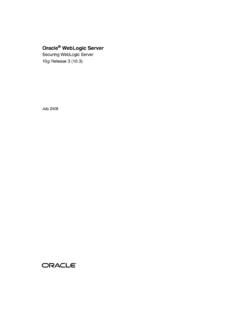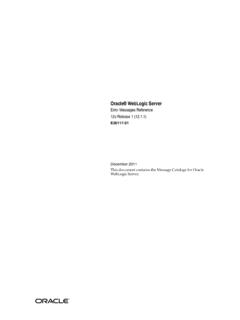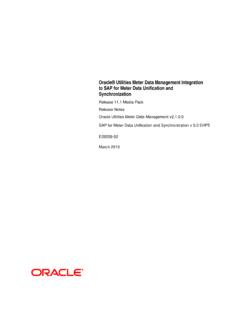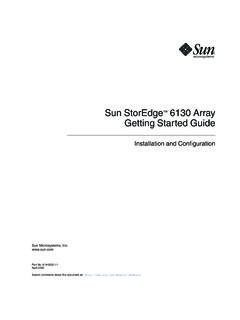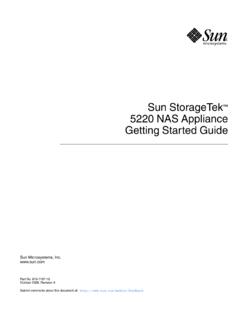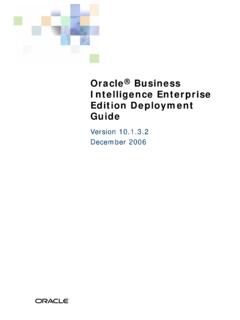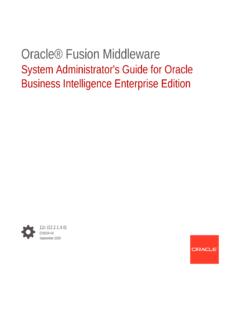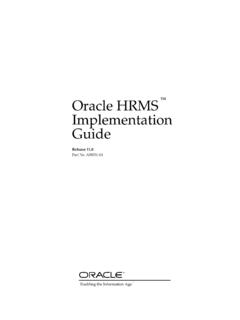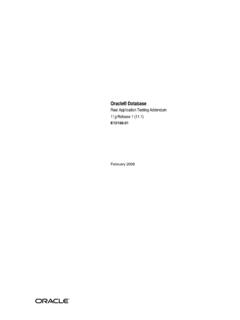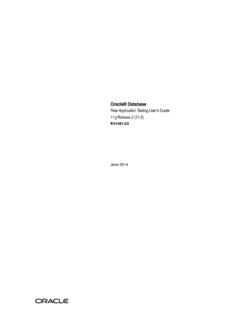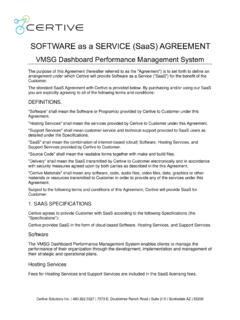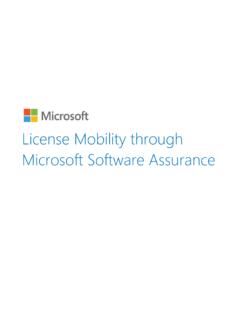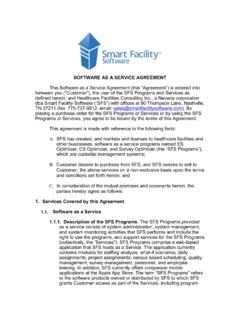Transcription of Setting Up and Configuring Account Reconciliation - Oracle
1 Oracle Fusion Cloud EPMS etting Up and Configuring AccountReconciliationE94353-46 Oracle Fusion Cloud EPM Setting Up and Configuring Account Reconciliation ,E94353-46 Copyright 2016, 2022, Oracle and/or its Author: EPM Information Development TeamThis software and related documentation are provided under a license agreement containing restrictions onuse and disclosure and are protected by intellectual property laws. Except as expressly permitted in yourlicense agreement or allowed by law, you may not use, copy, reproduce, translate, broadcast, modify, license,transmit, distribute, exhibit, perform, publish, or display any part, in any form, or by any means. Reverseengineering, disassembly, or decompilation of this software , unless required by law for interoperability, information contained herein is subject to change without notice and is not warranted to be error-free. Ifyou find any errors, please report them to us in this is software or related documentation that is delivered to the Government or anyone licensing it onbehalf of the Government, then the following notice is GOVERNMENT END USERS: Oracle programs (including any operating system, integrated software ,any programs embedded, installed or activated on delivered hardware, and modifications of such programs)and Oracle computer documentation or other Oracle data delivered to or accessed by Government endusers are "commercial computer software " or "commercial computer software documentation" pursuant to theapplicable Federal Acquisition Regulation and agency-specific supplemental regulations.
2 As such, the use,reproduction, duplication, release, display, disclosure, modification, preparation of derivative works, and/oradaptation of i) Oracle programs (including any operating system, integrated software , any programsembedded, installed or activated on delivered hardware, and modifications of such programs), ii) Oraclecomputer documentation and/or iii) other Oracle data, is subject to the rights and limitations specified in thelicense contained in the applicable contract. The terms governing the Government s use of Oracle cloudservices are defined by the applicable contract for such services. No other rights are granted to the software or hardware is developed for general use in a variety of information management is not developed or intended for use in any inherently dangerous applications, including applications thatmay create a risk of personal injury. If you use this software or hardware in dangerous applications, then youshall be responsible to take all appropriate fail-safe, backup, redundancy, and other measures to ensure itssafe use.
3 Oracle Corporation and its affiliates disclaim any liability for any damages caused by use of thissoftware or hardware in dangerous , Java, and MySQL are registered trademarks of Oracle and/or its affiliates. Other names may betrademarks of their respective and Intel Inside are trademarks or registered trademarks of Intel Corporation. All SPARC trademarks areused under license and are trademarks or registered trademarks of SPARC International, Inc. AMD, Epyc,and the AMD logo are trademarks or registered trademarks of Advanced Micro Devices. UNIX is a registeredtrademark of The Open software or hardware and documentation may provide access to or information about content, products,and services from third parties. Oracle Corporation and its affiliates are not responsible for and expresslydisclaim all warranties of any kind with respect to third-party content, products, and services unless otherwiseset forth in an applicable agreement between you and Oracle .
4 Oracle Corporation and its affiliates will not beresponsible for any loss, costs, or damages incurred due to your access to or use of third-party content,products, or services, except as set forth in an applicable agreement between you and Documentation Accessibility Documentation FeedbackPart I Setting Up Reconciliation Compliance1 Learning About Setup and Configuration in Reconciliation ComplianceOverview of Reconciliation Compliance Configuration1-1 Configuring Periods1-5 Setting Up Formats1-6 Creating Profiles1-6 Configuring Data Loads1-6 Period-Specific Tasks1-7 Training Users, Performing Acceptance Testing, and Migrating to Production1-7 Working with Views, Lists, and Filters1-8 Working With Views1-8 Working with List Views1-12 Working with Filters1-132 Learning About Setup Best Practices3 Configuring Reconciliation ComplianceDefining Attributes3-1 Creating Attributes3-1 Importing List Attributes3-11 Defining System Attributes3-11 Defining Profile Segments3-12 Creating Profile Segments3-13iiiImporting Profile Segments3-14 Defining Process System Attribute3-14 Defining Risk Ratings System Attribute3-14 Defining Frequencies3-15 Creating Frequencies3-15 Deleting Frequencies3-15 Defining Account Type System Attribute3-15 Defining Aging Profiles3-16 Creating Aging Profiles3-16 Defining Global Integration Tokens3-16 Defining Currency3-17 Defining Currency Rates3-17 Importing Currency Rates3-18 Creating Currency Rates Manually3-18 Defining Currency Buckets3-19 Controlling Currencies3-20 Creating Custom Currencies3-20 Defining Rate Types3-20 Creating Rate Types3-21 Defining Calendars3-21 Defining Holiday
5 Rules3-23 Importing Holiday Dates3-23 Defining Organizational Units3-24 Importing Organizational Units3-26 Selecting an Organizational Unit3-26 Defining System Settings3-27 Allowing Comment Deletions3-27 Allowing Bulk Updates by Users3-28 Data Load Timeout3-28 Settings for EPM Digital Assistant3-28 Setting Up Service Time Zone and Due Dates3-29 Enabling Email Notifications3-30 Email Notification Settings Reference3-31 Setting Maximum Number of Items Displayed in a List3-34 Setting the Maximum Attachment Size3-34 Using Oracle Cloud Object Storage to Store Attachments 3-35 About Using Oracle Cloud Object Storage to Store Attachments3-35 Understanding What is Stored on OCI Object Storage3-35 Steps to Use OCI Object Storage with Account Reconciliation 3-36 Using Replication for Your Object Storage Bucket3-40 Allow Workflow Users to Perform and Approve Reassignment Requests3-40ivReopening Reconciliations 3-41 Setting Reviewer Levels3-42 Managing System Maintenance3-43 Settings for Transaction Matching3-444 Configuring PeriodsOverview of Configuring Periods4-1 Creating Periods4-2 Importing Multiple Periods from a File4-2 Filtering the Periods List4-5 Changing a Period's Status4-6 Opening Periods4-7 Closing and Locking Periods4-7 Checking for Missing Reconciliations4-9 Viewing Period History4-10 Editing Periods4-10 Deleting Periods4-105 Defining FormatsLearning About Formats5-1 Using Standard Formats5-4 Creating Formats5-5 Deleting Formats5-8 Working With Format Rules5-8 Order of Precedence for Auto Reconciliation and Rules5-11 Specifying Format Instructions5-17 Adding Format Attributes5-17 Specifying Format Questions5-196 Working with ProfilesDefining Profiles6-1 Creating Profiles6-2 Reason Codes for Auto- Reconciliation Failures6-8 Creating Profiles for Variance Analysis6-9 Creating Profile Instructions6-10 Assigning Profile Workflows6-11 Specifying Profile Currencies6-13
6 Specifying Profile Access6-13 Specifying Profile Attributes6-14vWorking With Profile Rules6-15 Order of Precedence for Auto Reconciliation and Rules6-18 Viewing Profile History6-24 Adding Accounts6-24 Using Excel CSV Files for Profiles6-24 Importing Profiles6-25 Exporting Profiles6-26 Deleting Profiles or Reconciliations6-28 Using the Profile Actions Panel6-30 Copying Profiles to Period6-30 Duplicating Profiles6-307 Working with Group ReconciliationsAdministrator Set Up Tasks for Group Reconciliations7-2 Part II Setting Up Transaction Matching8 Learning About Transaction MatchingUnderstanding the Transaction Matching Engine8-39 Setting Up Transaction Matching OverviewAbout Match Type Views for Data Sources9-2 Creating Match Types9-4 Defining Data Sources9-6 Working with Transaction Types9-15 Defining the Match Process by Creating Rules9-19 Using a Subset Rule During Creation of 1 to Many and Many to 1 Rules9-28 Using a Subset During Creation of Many to Many Rules9-30 Using Multiple Data Sources and Multiple Match Processes9-31 Filtering and Grouping Transactions in AutoMatch Rules9-34 Setting Up One Sided Adjustments to Run During Auto-Match9-36 Setting Up Default Adjustment and Support Values9-40 Changing Defaults for Batch Size and Maximum Iterations for Auto Match Rules9-46 Editing and Deleting Match Types9-48 Exporting and Importing of Match Types Across Environments9-48 Defining Formats and Profiles for Transaction Matching9-50vi10 Exporting Adjustments or Transactions as Journal EntriesCreating Global Adjustment and Support Attributes10-2 Defining the Journal Columns10-4 Exporting to a Text File in Jobs History10-5 Map Attributes to Journal Attributes10-9A Appendix.
7 Reconciliation List Select Column DefinitionsviiDocumentation AccessibilityFor information about Oracle 's commitment to accessibility, visit the OracleAccessibility Program website at to Oracle SupportOracle customers that have purchased support have access to electronic supportthrough My Oracle Support. For information, visit or visit you are hearing AccessibilityviiiDocumentation FeedbackTo provide feedback on this documentation, click the feedback button at the bottom of thepage in any Oracle Help Center topic. You can also send email to ISetting Up Reconciliation ComplianceRelated Topics Learning About Setup and Configuration in Reconciliation Compliance Learning About Setup Best Practices Configuring Reconciliation Compliance Configuring Periods Defining Formats Working with Profiles Working with Group Reconciliations1 Learning About Setup and Configuration inReconciliation ComplianceRelated Topics Overview of Reconciliation Compliance Configuration Configuring Periods Setting Up Formats Creating Profiles Configuring Data Loads Period-Specific Tasks Training Users, Performing Acceptance Testing, and Migrating to Production Working with Views, Lists, and FiltersOverview of Reconciliation Compliance ConfigurationThe first task in Setting up Reconciliation Compliance is to configure different settingsavailable from Home, then Application, and then has the following easy access to various features and settings.
8 Alert Types1-1 Attributes System Attributes Currencies Data Loads Filters Formats Lists Organizations Periods Settings (System Settings)Alert TypesAlerts allow communication between a user having an issue while working towardsclosing a Reconciliation , and other users that may be able to help resolve the types are created by administrators to define a procedure to follow when certainissues arise. See Creating Alert TypesAttributesCustom attributes are user-defined fields defined centrally by administrators and canbe used in reconciliations, profiles and formats:In Profiles: Administrators and power users can assign attributes to profiles to captureinformation that is not supported by the standard attributes. In Formats: Administratorscan assign attributes to formats to appear on reconciliations in two tab appears first on the list since you will access this often while managingAccount Reconciliation . See Creating Attributes for details on how to create System AttributesUnder System Attributes, you define these attributes of profiles and reconciliations: Profile Segments are the components of the Account ID used to uniquely identifyprofiles and reconciliations.
9 For example, if you typically reconcile accounts at theCompany- Account level, then you should define two segments: one for Company,and one for Account . Profile Segment values are labels. They don t control themapping of balances to reconciliations which occur through mapping rules addedin the data load definitions or by pre-mapping balances before import. Process distinguishes between reconciliations for different purposes, such as apre-defined Balance Sheet process. You can remove this option if you prefer 1 Overview of Reconciliation Compliance Configuration1-2 Risk Ratingsare tags assigned to reconciliations to help with reporting and analysis suchas High, Medium, or Frequencies determine how often reconciliations are prepared. "Monthly" and"Quarterly" are typical frequencies. In System Settings, you define the frequencies. Youalso need to assign frequencies to profiles and periods. Reconciliations are only createdwhen the frequency assigned to the profile matches the frequency assigned to the period.
10 Account Type are tags assigned to reconciliations to help with reporting and analysissuch as Assets, Liabilities, or Equity. Aging Profiles Aging Profiles are used in reports to classify transactions into agingbucketsthat you define. For example, you might define an Aging Profile consisting of thefollowing buckets: 0-15 days, 16-30, 30-60, 61-90, and greater than 90 days. You canreview reports that display the count or value of transactions within each aging bucket. Global Integration Tokens are used when parameterized reports should be accessiblefrom the Reconciliation . For example, if you are using BI Publisher to generate FixedAsset Rollforward schedules, then you can use Global Integration Tokens to passparameters such as Account ID or Period into the report so it displays the correct CurrenciesThe Currency section enables configuration of Currency Buckets, Rate Types, andCurrencies. Currency Rates See Defining Currency RatesCurrency Buckets should be defined for each bucket that must be certified in reconciliations,and for any additional buckets that make it easy to prepare the reconciliations.
